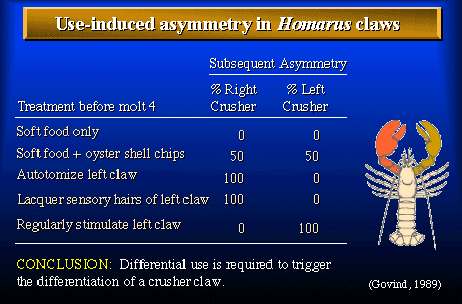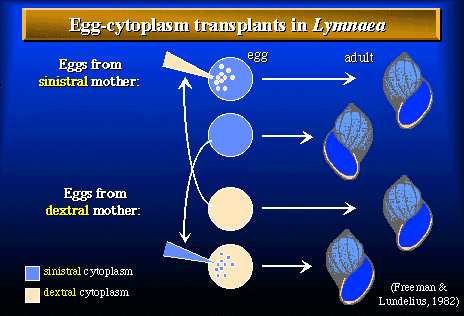
For some conspicuously asymmetrical structures, such as the claws of lobsters (Homarus americanus), cues from the external environment induce the larger side to develop on one side or the other.

Although adult lobsters posses a larger crusher claw on one side and a smaller cutter claw on the other, the claws of newly settled lobsters are symmetrical. Asymmetry does not appear until after the fourth molt. Some simple, yet very clever experiments by C.K. Govind (University of Toronto) show that the more actively stimulated claw during the fourth molt will become the crusher claw in the fifth molt.
Significantly, lobster claws exhibit random asymmetry: crusher claws are equally likely to occur on the right or left sides. Therefore, random asymmetry (also called antisymmetry) may signal that symmetry is broken by random effects of the external environment.
Other conspicuous asymmetries, such as the coiling direction of snails, appear to be controlled by heterogeneities in the cell cytoplasm.

Both right-handed (dextral) and left-handed (sinistral) shells occur in the freshwater snail, Lymnaea peregra. In Lymnaea, as well as other snails polymorphic for coiling direction, a single gene (or two tightly linked ones) determines the direction of coiling. Curiously, the phenotype of the offspring reflects the genotype of the mother, rather than its own genotype. Gary Freeman & Judith Lundelius (University of Texas, Austin) used micropipettes to transplant cytoplasm from eggs of dextral mothers into eggs of sinistral mothers. These transplants caused the direction of spiral cleavage to switch, which in turn reversed the coiling direction of the shell in adult snails.
Significantly, snails normally exhibit fixed asymmetry: the direction of coiling is almost always constant within a species. Even where it is polymorphic, the frequencies of dextral & sinistral forms is rarely 50:50, in contrast to what is observed for lobsters. These fixed asymmetries suggest that symmetry is not broken by random effects of the external environment.
Back to Asymmetry Page
A.R. Palmer
Home Page
Original material on this page copyright © 1997-2002 by A. Richard Palmer. All rights reserved.
(revised Nov. 14, 2002)